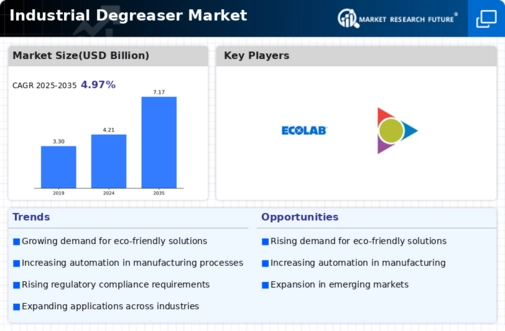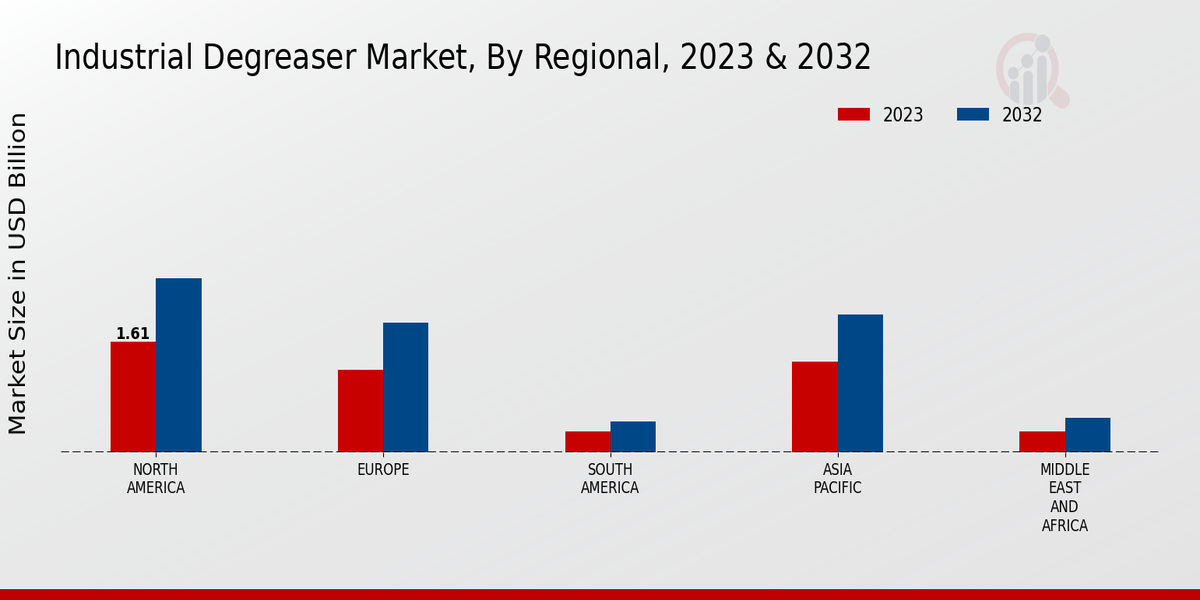Market Growth Projections
The Global Industrial Degreaser Market Industry is poised for substantial growth, with projections indicating a rise from 4.21 USD Billion in 2024 to 7.17 USD Billion by 2035. This growth trajectory suggests a compound annual growth rate of 4.97% from 2025 to 2035, reflecting increasing demand across various sectors. Factors contributing to this growth include technological advancements, regulatory pressures, and the rising need for eco-friendly solutions. As industries evolve and adapt to changing market conditions, the industrial degreaser market is likely to expand, presenting opportunities for innovation and investment.
Stringent Regulatory Frameworks
The Global Industrial Degreaser Market Industry is heavily influenced by stringent regulatory frameworks aimed at reducing environmental impact. Governments worldwide are implementing regulations that mandate the use of safer, less harmful cleaning agents in industrial applications. Compliance with these regulations often necessitates the adoption of advanced degreasing solutions that meet environmental standards. This regulatory pressure is driving manufacturers to innovate and reformulate their products, thereby expanding the market for compliant degreasers. As industries adapt to these regulations, the demand for compliant industrial degreasers is expected to rise, further propelling market growth.
Growth of the Manufacturing Sector
The expansion of the manufacturing sector globally is a key driver for the Global Industrial Degreaser Market Industry. As production activities ramp up, the need for effective cleaning solutions becomes paramount to maintain equipment and ensure operational efficiency. Industries such as aerospace, automotive, and electronics are particularly reliant on degreasers to uphold quality standards. The projected growth of the manufacturing sector is expected to contribute significantly to the market, with estimates suggesting a rise to 7.17 USD Billion by 2035. This growth underscores the critical role that industrial degreasers play in maintaining productivity and safety in manufacturing environments.
Increased Focus on Workplace Safety
Workplace safety is becoming an increasingly critical concern across various industries, thereby impacting the Global Industrial Degreaser Market Industry. The use of hazardous chemicals in degreasers poses risks to worker health and safety, prompting companies to seek safer alternatives. This focus on safety is leading to a shift towards non-toxic and less hazardous degreasing agents. Industries such as food processing and pharmaceuticals are particularly sensitive to these concerns, as they require stringent safety standards. As organizations prioritize employee well-being, the demand for safer industrial degreasers is likely to grow, influencing market dynamics.
Rising Demand for Eco-Friendly Solutions
The Global Industrial Degreaser Market Industry is experiencing a notable shift towards environmentally friendly cleaning solutions. As industries increasingly prioritize sustainability, the demand for biodegradable and non-toxic degreasers is on the rise. This trend is evident in sectors such as automotive and manufacturing, where companies are adopting greener practices to comply with stringent regulations. The market is projected to reach 4.21 USD Billion in 2024, reflecting a growing consumer preference for eco-conscious products. This shift not only addresses environmental concerns but also enhances corporate image, potentially leading to increased market share for companies that embrace these changes.
Technological Advancements in Formulations
Innovations in chemical formulations are significantly influencing the Global Industrial Degreaser Market Industry. Manufacturers are investing in research and development to create more effective and efficient degreasers that require less product for optimal results. For instance, advancements in surfactant technology have led to the development of degreasers that can penetrate and dissolve grease more effectively. This not only improves cleaning efficiency but also reduces the volume of chemicals needed, aligning with sustainability goals. As a result, the market is expected to grow at a CAGR of 4.97% from 2025 to 2035, indicating a robust future driven by technological progress.













